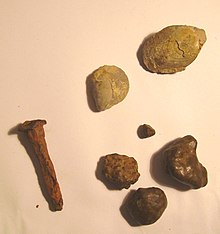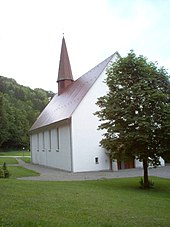Laucherthal
|
Laucherthal
Community Sigmaringendorf
Coordinates: 48 ° 5 ′ 0 ″ N , 9 ° 16 ′ 32 ″ E
|
|
|---|---|
| Height : | 626 m above sea level NN |
| Area : | 76 ha |
| Residents : | 643 |
| Population density : | 846 inhabitants / km² |
| Incorporation : | 1708 |
| Postal code : | 72517 |
| Area code : | 07571 |
Laucherthal is a hamlet in the town Sigmaringendorf in Baden-Wuerttemberg Sigmaringen district with 643 residents. The village emerged as a workers' settlement in 1708 when Prince Meinrad II of Hohenzollern-Sigmaringen set up an iron smelter there to smelt the ore found above ground in the area .
geography
Laucherthal lies at 626 m above sea level. NN embedded in the idyllic Lauchert valley and belongs to the Upper Danube nature park .
history
In the fields above the village and in the surrounding area there are burial mounds (in the vernacular the so-called “Hennabühl”, probably not derived from the numerous partridges (henna) that exist there , but from Heunenbühl = Hunnenhügel, from Middle High German Huine , Hüne = giant and bühel = hill). The burial mounds are said to date from Celtic and pre-Celtic times.
The Romans are said to have mined the iron ore and an ore washing plant is said to have stood at the site of today's hot rolling mill on the Lauchert. In even earlier times the Celts, whose well-known prince seat, the “ Heuneburg ”, is only a few kilometers away, are said to have used the ore from the area, also as an object of exchange in trade with Greece.
In the 19th century the forests must still have been full of deer, because in the chronicle of Sigmaringendorf there is the report of the chronicler of the time that the usual costume of men consisted of deerskin trousers. Nowadays, deer are only found in the neighboring Josefslust Wildlife Park in Sigmaringen. Child mortality at that time was extremely high, and the pastor attributes this to the effects of the metal-containing water. Rheumatism and / or gout were already common in children.
At the edge of the village is the so-called “Gypsy Grove”, in which up until a few years ago, rural travelers set up camp in a periodic cycle. After the permitted period you should have simply changed the side of the street, i.e. from Hohenzollern to Württemberg, in order to be able to stay a few days longer.
During the Second World War, there was a forced labor camp on the outskirts of the village in the direction of Hitzkofen , in which mainly Poles and Ukrainians were held. After the war, some stayed in the village. The grounds of the camp are now built on, and some of the sheds on the land and the fences come from the remains of the camp.
After the war, Hohenzollern became a French zone of occupation , and the French who moved in (initially mostly Maghrebians ) were almost worse off than the locals, they even had scurvy . The guest workers' barracks, which were first inhabited by southern Italians, then by Yugoslavs and Turks, still stand today.
The Laucherthal settlement grew over time and eventually grew together with the community of Sigmaringendorf. Since the floor ore found here does not have a sufficiently high proportion of iron , but a lot of manganese , smelting became unprofitable over time and the blast furnace was shut down. However, the former steelworks still exists as a modern metal processing company, now under the name Zollern GmbH und Co. KG .
Religions
- Catholic parish of St. Meinrad in Laucherthal
Culture and sights
Laucherthal is on the Hohenzollernstrasse .
Museums
- The former blast furnace can be viewed in the iron and steel works. Traces of the former ore mining can be seen in the surrounding forests and on fields as pits that are partially full of water (“perennial pit”).
- The Villa Rustica in Laucherthal was a Roman estate ( villa rustica ), the remains of which are located near the "Schludegrube" behind the ironworks. Remains of limestone walls covered with grass can be seen ( 48 ° 5 ′ 26.4 ″ N , 9 ° 16 ′ 2.3 ″ E ).
societies
- Fasnachtsgesellschaft Laucherthal / Friends of the Fasnachtsgesellschaft Laucherthal
- Laucherthal hut chapel
- Association of former FHH employees
- Laucherthal plant fire brigade
Buildings
- The Church of St. Meinrad Laucherthal celebrated its 50th anniversary on October 19, 2008. Already at the beginning of the 19th century there were efforts in Laucherthal to create their own church rooms. At the urgent request of Pastor Emil Glöckler, Prince Friedrich provided 8000 Reichsmarks and a piece of land for a church building in 1935, with the condition that the church should be named St. Meinrad, based on Prince Meinrad II. Shortly after the war, the first St. Meinrad's Chapel was inaugurated in 1946 in a building behind the ironworks administration. The desire for a church remained. With strong support from the Princely House of Hohenzollern and the community, after a church building association was founded in 1955, the foundation stone for a church in the Untere Hühlen area was laid on the idyllic edge of the forest on October 7, 1956 . The church consecration with the patron saint St. Meinrad took place on July 12, 1958 by Archbishop Hermann Schäufele . The church had already been temporarily occupied in 1957. In 1960 the church got an organ and a year later the bells. The Sunday services in Laucherthal were held until 1961 by priests from Gorheim Monastery . In 1977 water ingress destroyed the floor and the electric bench heating.
- The smelting works' blast furnace building , built at the beginning of the 18th century, was in operation until May 3, 1879. After its renovation, the building will be used as a museum; the German Foundation for Monument Protection funded its preservation with 125,000 euros in 2007.
Natural monuments
During the Jurassic period, the whole area was part of a tropical sea, and so in its deposits, the limestone rocks that are visible everywhere, caves, fossils and minerals ( ammonites , shells, corals , sponges , quartz , calcite , agate bulbs , etc.) can be found. What is sometimes taken to be fossilized plants are often dendrites , deposits of minerals (manganese oxide, brown) that penetrate the porous rock with water.
Regular events
At Carnival , the local carnival society recreates a "gypsy camp", which has, however, been criticized, also because of the use of the word " gypsy ".
A special feature of the Laucherthäler Fasnet is the members of the “Melt Guild”, dressed in blue and white “waltz blouses”, black caps and wooden shoes, who carry their ancestors' equipment, iron tongs and melting pots through the streets. " Bringing " is also practiced: newlyweds or anniversaries are put on a pole, carried around in a circle by four porters, and then thrown into the air three times inside the "Fridolin Hüttengasthof". While carrying around, the porters sing the song: "Sit on nauf uf d´Stang, sit on nauf uf d´Stang, Schmelzer should he stay, be all Läaba long". During the “straw man driving ” on the “ Schmotziga Donschdig ”, an unmarried man is wrapped in straw and driven through the village with air-filled pig bladders attached to sticks with strings, with children following him and catching sweets that the residents throw at them.
On December 4th, Barbaratag , Laucherthaler and employees of the iron and steel works commemorate Saint Barbara , patron saint of miners and the fallen and missing Zollern employees of the two world wars at the Barbarage memorial next to the former blast furnace .
Economy and Infrastructure
traffic
- Local public transport through the Neckar-Alb-Donau transport association (NALDO)
- Landstrasse 455 (L 455 - Sigmaringendorf - Hitzkofen)
Established businesses
- ZOLLERN GmbH + Co. KG , formerly "Fürstlich Hohenzollernsche Werke Laucherthal - iron smelting with hammer forge" (investment casting, bronze casting, bronze forgings, profile steel)
education
- Kindergarten St. Meinrad
Personalities
Honorary citizen of the community of Sigmaringendorf
- Friedrich Wilhelm von Hohenzollern (born February 3, 1924 - † September 16, 2010), at the end of the 1970s during a steel crisis, he had to sell parts of the family property to maintain the "Laucherthal ironworks".
annotation
- ^ Chronicle of the community of Sigmaringendorf
- ^ Anton Speh: St. Meinrad. Laucherthal commemorates the church anniversary . In: Schwäbische Zeitung from October 17, 2008
- ^ Anton Speh: Lecture. Fürst donates 8,000 Reichsmarks . In: Schwäbische Zeitung from October 23, 2008
- ↑ 125,000 euros for the preservation of the historic blast furnace in Sigmaringendorf . In: Südkurier of October 8, 2007
- ↑ named after the ballad 'A pious servant was Fridolin' by Schiller, where the villain burns in the furnace
- ↑ Anton Speh: Zollern employees remember the fallen and missing . In: Schwäbische Zeitung from December 6, 2008


